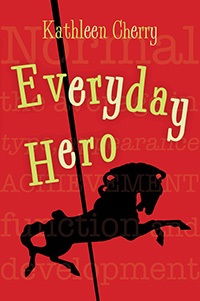| ________________
CM . . .
. Volume XXII Number 14. . . .December 4, 2015
excerpt:
Alice is attending a new middle school where nobody is aware of her Asperger’s diagnosis. She lives with her father while her mother temporarily remains behind in Vancouver to assist aging parents. Alice admires Megan, a classmate she meets in detention, for her seeming fearlessness. It is this same quality that causes Megan to appreciate Alice later in the story when the two girls understand each other better. It is Alice’s unfailing loyalty to Megan that saves her from an online predator as well as supports her in seeking safety through foster care. Part of Alice’s unique abilities involve a detail-oriented memory, and Kathleen Cherry does a remarkable job of presenting Alice’s stream-of-consciousness thinking without letting it weigh down the story. The character’s tendency to focus on multiple definitions of words, in situations that perplex her, assists readers in understanding Alice’s point of view, and her reliance on previous experiences and rules when interpreting new situations captures an important aspect of autism. Throughout the story, however, her different way of thinking is presented without judgement—a respectful treatment and one Alice, herself, would appreciate as she begins to recognize that, while she is not “average in type, appearance, achievement, function and development”, “being average is highly overrated.” As Alice relates the story of her developing friendship with Megan, it unfolds as an honest account by an unfailingly accurate and likeable narrator. Her challenges with sensory stimulation and verbal communication are only part of her rich characterization, and readers will immediately perceive that there is a great deal more to Alice than any kind of diagnosis would suggest. This leads into an issue that Alice’s parents are struggling with, not uncommon in families where decisions about revealing diagnostic information are often divisive and difficult. While her mother appears to be somewhat overprotective, and has facilitated past home and school communications, her father, hopeful that Alice will pass for “normal” in her new school setting, encourages her to try and blend in. It is Alice, herself, who eventually makes a decision that supports accommodations on behalf of her brain differences, but in addition to the confidential information from her previous school file, she also wishes her new school team to know that she is “a hero and a friend”. While the short sentences and straightforward plot present this book as a story for younger readers, its characterization of Megan, a girl abused by her stepfather, may resonate more clearly with ages 10 to 12. Older children and adults, however, will overlook the intended audience in favour of the delightfully fresh perspective Alice provides. It is also noteworthy that on a landscape of Canadian literature for young people where characters with exceptionalities often reside with single mothers, Alice’s father, in spite of his imperfections, is definitely a keeper. Highly Recommended.
Bev Brenna is a Saskatchewan university professor and writer whose trilogy about a teen with Asperger’s Syndrome has earned a variety of accolades.
To comment on this title or this review, send mail to cm@umanitoba.ca.
Copyright © the Manitoba Library Association. Reproduction for personal use is permitted only if this copyright notice is maintained. Any
other reproduction is prohibited without permission.
CM Home |
Next Review |
(Table of Contents for This Issue - December 4, 2015.)
| Back Issues | Search | CM Archive
| Profiles Archive |
